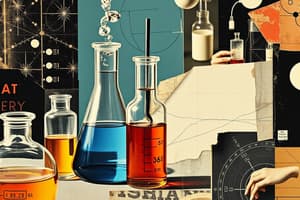Podcast
Questions and Answers
What is the primary characteristic of a chemical change?
What is the primary characteristic of a chemical change?
- A change in temperature or pressure only
- Mixing of two substances resulting in a solution
- Change in physical appearance without altering the composition
- Creation of a new substance through atom rearrangement (correct)
Which of the following statements about acids and alkalines is correct?
Which of the following statements about acids and alkalines is correct?
- An acidic solution has a pH greater than 7.
- A pH of 7 indicates an acidic solution.
- Acidic solutions have more hydrogen ions than alkalines. (correct)
- Alkaline solutions contain more hydrogen ions than water.
Which of the following describes a surfactant?
Which of the following describes a surfactant?
- A substance that helps oil and water to mix (correct)
- A mixture of different elements in equal parts
- A type of acid that increases solution pH
- A form of energy produced in chemical reactions
What is a key difference between a mixture and a compound?
What is a key difference between a mixture and a compound?
Which statement accurately defines a molecule?
Which statement accurately defines a molecule?
Study Notes
Matter and Elements
- Matter is anything that occupies space and has mass.
- Elements are the simplest form of a chemical substance.
- There are 98 naturally occurring elements on Earth.
Atoms and Subatomic Particles
- Atoms are the basic unit of matter.
- Subatomic particles are the building blocks of atoms.
- Protons are positively charged particles found in the nucleus of an atom.
- Electrons are negatively charged particles that orbit the nucleus.
Surfactants
- Surfactants are substances that allow oil and water to mix.
- They emulsify water droplets in oil and oil droplets in water.
Chemical vs. Physical Changes
- Physical changes alter the form of a substance but not its chemical composition. For example, ice melting into water.
- Chemical changes result in a new substance, altering the structure of the material. These are caused by chemical reactions.
Mixtures and Solutions
- Mixtures are combinations of two or more substances that are not chemically bonded.
- Solutions are stable uniform mixtures of two or more substances.
- The substance that dissolves is the solvent, and the substance dissolved is the solute.
pH and Ionization
- pH measures the acidity or alkalinity of a solution.
- Acidic solutions have a pH below 7 and contain more hydrogen ions.
- Alkaline or basic solutions have a pH above 7 and contain fewer hydrogen ions.
- Ionization is the separation of an atom or molecule into positive or negative ions.
Molecules and Compounds
- Molecules are groups of two or more atoms bonded together.
- Compounds are combinations of two or more different elements in definite proportions.
Emulsions
- Emulsions are mixtures of two liquids that usually don't mix together, such as oil and water.
Studying That Suits You
Use AI to generate personalized quizzes and flashcards to suit your learning preferences.
Description
This quiz covers essential chemistry concepts including matter, elements, atoms, and surfactants. Understand the differences between chemical and physical changes as well as mixtures and solutions. Test your knowledge and grasp the fundamentals of chemistry through this comprehensive quiz.




